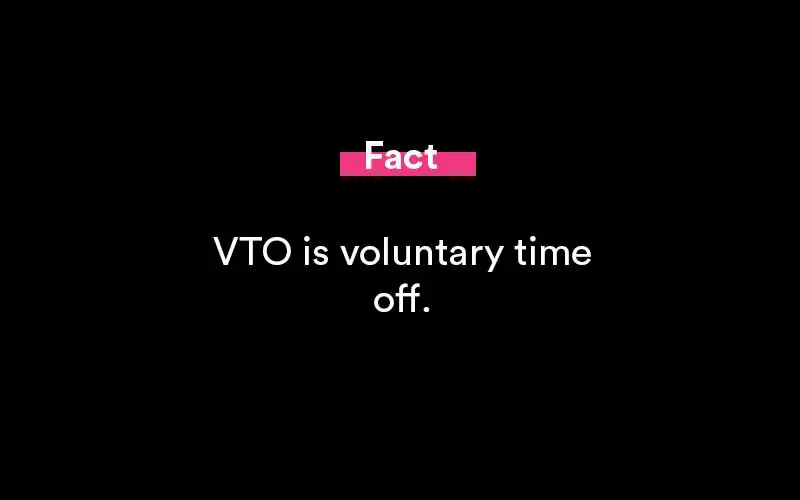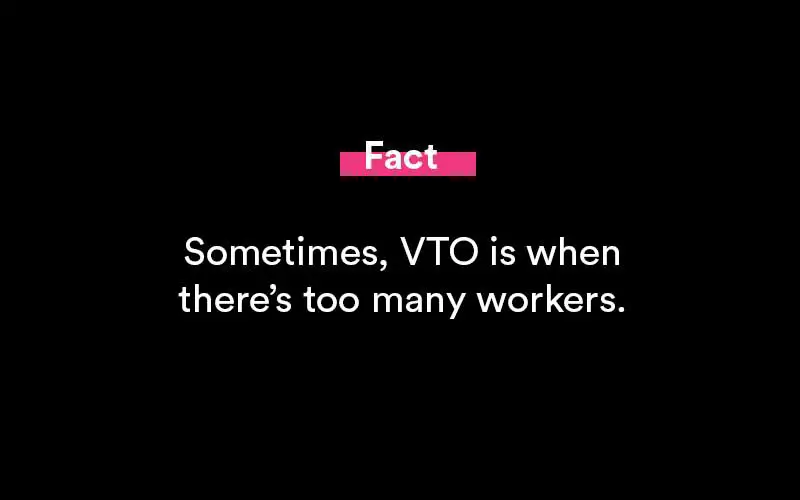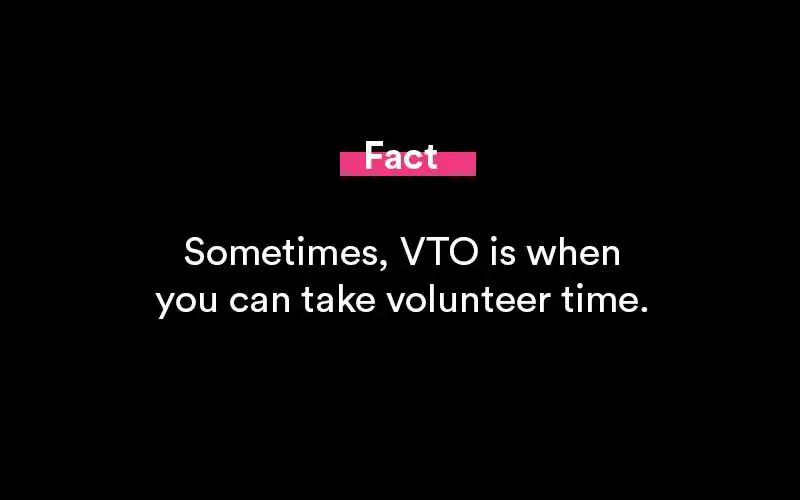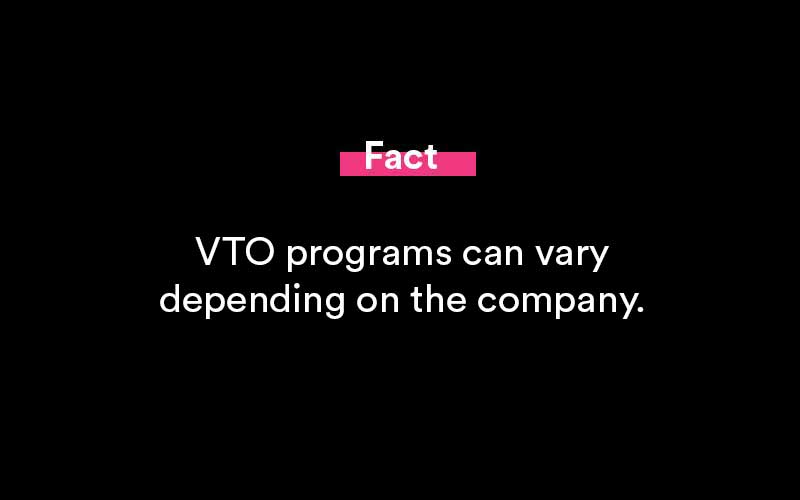What is VTO? (Voluntary Time-Off)
What is VTO? VTO refers to either voluntary time off or volunteer time off. These are the various types of leave policies that businesses employ. Serve time off is a term that refers to the practice of allowing employees to volunteer in their communities while continuing to receive compensation; it is a type of paid time off (PTO).

What is VTO?
Both volunteer time off and voluntary time off is considered VTO. These are two distinct leave policies offered by corporations to encourage employees to contribute to the company and mitigate the costs associated with inefficient scheduling.
HR must grasp both intricacies to develop employee leave policies that encompass a variety of distinct time-off policies.
What is a voluntary leave of absence?
Voluntary time off (VTO) is a type of leave that businesses employ to balance personnel needs with constantly changing workloads. Schedule creation isn't an exact science. Occasionally, an excessive number of workers can be scheduled in a shift due to unforeseen circumstances. In that instance, the corporation may pay high labor costs. Some businesses enable the additional employees to take unpaid time off to save money when this occurs.
Although employers attempt to sell voluntary time off to employees as an opportunity, it benefits employers. Voluntary time off must also allow employees to take time off without facing sanctions. If the relationship is one-sided, it may appear manipulative.
Voluntary time off, when appropriately implemented, can provide employees with an opportunity for work-life integration while also lowering the company's costs.
What is volunteer time off?
Volunteer time off is a type of paid leave and an employee benefit. Businesses provide paid time off for employees to volunteer at community events. Companies provide VTO to their employees through partnerships with non-profit organizations or allowing employees to choose their organization.
Is VTO a for-profit organization?
Volunteer time off is when employers provide paid time off to their employees in exchange for them volunteering in their communities. Along with the benefit of allowing employees to pursue their passions, businesses earn brownie points for their corporate social responsibility efforts.
On the other side, businesses provide unpaid time off to their employees.

General policies on VTO
On the one hand, optional time off may be available to an employee who works for the company full-time. On the other hand, employees who take unpaid leave or voluntary time off may reduce their hours below the minimum required for full-time status.
To avoid the latter, employers establish voluntary time-off policies that enable employees to retain perks and advance in their careers even after taking voluntary time off. As a result, the optional time-off policy is meaningless if employees choose not to make use of it. Another problem is that voluntary time off might result in an office being empty and operations getting disrupted due to an imbalance between remaining work and available staff.
Allowing employees to use volunteer time can encourage their use, and the policy can allow employees to use voluntary time after they exhaust their paid leave. A corporation may demand clearance for requests for voluntary time off. In a similar vein, businesses can implement a voluntary time off policy that requires employees to exhaust their paid leave before being eligible for volunteer time off.

Unpaid VTO
Incorporating cost-cutting techniques is one of the best practices for voluntary time off. A business may be required to pay the employer share for employees who take voluntary time off. At the same time, the corporation saves money by not paying the employee's salary and compensation. In this approach, a voluntary time-off policy can boost employee happiness and help businesses avoid economic difficulties.
Advantages of VTO programs
Voluntary time-off programs can help businesses manage employee idle time. However, voluntary time off can occasionally result in an imbalance between staffing and workload.
Employees may also experience confusion and struggle while selecting whether to take VTO or continue working and earning money. VTO programs can create a poor perception of the company and employer among employees, who believe that the employer's bottom line is more important than the employees' attempts to be available for a shift.

Volunteer leave of absence
Businesses that voluntarily devote time to embracing corporate social responsibility permit their employees to take VTO. Companies do so to enable their employees to participate in community service activities.
Volunteer time off, or VTO, policies enable businesses to give back to their communities. While also providing its staff with something to do outside of work. Additionally, companies believe that giving back to the community helps create a brand and provides employees with a sense of pride in being affiliated with a firm that is not solely focused on profit.
Employees may volunteer up to 24 hours per calendar year. Employees can work for more than one company within the allotted hours. Additionally, businesses may maintain an approved list of philanthropic groups that adhere to specific volunteer requirements.
The hours can get divided as follows:
- Half-days off to participate in group service activities sponsored by the COMPANY (8 hours)
- Employees may take time off for personal volunteer work.
- Employees must complete and submit the VTO Request Form to their boss seven days before the requested time off. Such approval is at the manager's and human resources' discretion.
Best practices for enabling VTO
Volunteer time off or VTO time-off must be balanced with other types of leave to ensure that employees have appropriate vacation and sick leave discretionary time. Volunteer time off best practices is centered on community development through collaborations with non-profit organizations. Administrative responsibilities and event planning for the VTO program may be included in the responsibilities.
The best practices for volunteer time off include establishing appropriate standards and regulations to aid employees in selecting which organizations to support during their VTO time.
Best practices for volunteer time off should address particular questions such as the following:
- Can employees participate in political activities as volunteers?
- Are the non-values profits consistent with the values and aims of your organization?
- Who is responsible for approving VTO requests?
- What is the verification procedure that would be required of employees?
- Benefits of VTO
- Employer Benefits of VTO Recruitment
If a business has difficulty recruiting fresh talent, volunteer time off can help the industry attract potential employees. Persons between the ages of 18 and 34 are more likely to want to work for a company actively involved in community improvements and have previously aided in the growth of communities.
Offering VTO is an excellent recruitment strategy for Gen Z and millennial talent.
Employee turnover is minimal
Volunteer time off procedures assists businesses in retaining employees by allowing them to participate in activities outside of work. One of the most acceptable practices for volunteer time off is participating in charity activities that would enable employees to volunteer while interacting with teammates and coworkers.
VTO improves businesses by facilitating staff retention, which results in a significant decrease in attrition. Because employees get retained for a more extended period, the cost of acquiring new staff gets reduced.
Visibility of the corporation
Employees who participate in events to improve a society's or community's standard of living are more likely to promote a company's favorable brand image. Businesses can reap significant benefits from embracing this technique on multiple levels.
Why is VTO Beneficial to Employees?
Here's why VTO programs are beneficial to attract employees.
Empaths are in the ideal situation.
Around the world, increasing technology innovation has revolutionized how people communicate with one another. As a result, people's empathy has waned as most talks take place via smartphones and virtual meetings. There is, however, no shortage of people who wish to assist disadvantaged and deprived communities in flourishing and leading satisfying lives.
Compassionate employees are the primary cause of VTO perks' rising importance in recent years. Companies provide VTO chances to engage employees in contributing to the community's well-being.
Community sensitivity
Additionally, employees experience a sense of pride when their company's beliefs coincide with their own. VTO is also critical for employees, as it attracts individuals who are committed to the company's social values and responsibilities.
Employees who have a feeling of purpose are more likely to be satisfied with their employment, which positively affects their health. VTO instills healthy attitudes toward work-life balance in employees and fosters excellent relationships with coworkers and employers.
Additionally, the company that launches the VTO program benefits as its brand popularity and reputation in the community grow.
The impact of the VTO on business
The benefits of providing VTO to employees offer organizations a competitive edge. Among them are the following:
Recruiting a devoted workforce
The VTO policy contributes to the recruitment of personnel with a sense of purpose and a commitment to social and community values. Such candidates would also be amenable to matching their ethos and values with those of the organization.
Increased retention
Any policy that enables employees to live their principles effectively persuades them to remain with the firm. Additionally, it results in a lower turnover rate, particularly among millennial employees who are heavily involved in voluntary and charitable activities.
Increased job satisfaction among employees
Paid volunteer hours foster a sense of fulfillment among employees who believe the company is committed to positively impacting the larger community. As a result, people are more likely to exert more significant effort at work, resulting in productivity. Employees have a more favorable attitude toward work-life balance and stronger ties with coworkers.
VTO's disadvantages
Each human resource policy has some advantages and disadvantages, and similarly, the volunteer time off policy has some implementation disadvantages. For instance, an employee's absence due to volunteer time off may increase the burden in small businesses. It is critical to prepare in advance of such an occurrence in this regard.
Common FAQ's
Common questions about VTO programs.
Do warehouse workers receive VTO?
Yes. VTO often gets issued before the busy Christmas season. At Amazon. When Amazon warehouse employees' work quotas get met in advance, they can take VTO and leave early for the day. For employees, it's an opportunity to attend to personal matters or enjoy some more time off without utilizing vacation or sick days.
Is VTO paid?
No. VTO is unpaid time off that employees may take when their employer requests it due to a work slowdown.
What's the biggest drawback to VTO?
While voluntary time off rules might assist warehouses and contact centers cut unproductive hours, they can also perpetuate a staffing-workload mismatch. Additionally, employees may have difficulty while deciding whether to take VTO or stay and earn the money they require, particularly if management has VTO quotas to meet.
What's the most significant benefit of VTO?
These are only a few of the VTO benefits:
Saving money, creating positive feelings amongst employee personnel, and keeping more employees for longer periods of time.
What is voluntary pay from Amazon?
Under VSIP, agencies may pay up to $25,000 or the amount of severance compensation to which an employee is entitled, whichever is less. If approved, employees may resign, take optional retirement, or take voluntary early retirement to accept VSIP.
How is VTO time processed?
Generally, VTO requests get handled through HR. HR oversees the VTO program as part of employee benefits. They'll measure employee engagement, satisfaction, and retention as part of the benefits. And how the VTO program aligns with them. VTO hours get allocated per employee, per year. The HR department will approve VTO requests in advance, allowing employees to volunteer time to be available or take unpaid time off.
The company's values align with its VTO program, most commonly. And ensures that workers feel healthy. Both mentally and physically.
Popular Resources

Featured
35+ Phone Interview Questions & Best Sample Answers
Phone interviews have become a core part of the process when attempting to find a secured placement for an open position. Companies receive massive responses from potential candidates for any..

Featured
12+ Best Questions To Ask A Recruiter
Concerning a job search, you might receive numerous offers from your recruiters. Before you choose one, you need to assess all the conditions, for which it is vital that you know everything associated with the offered position..

Featured
Answering "What Makes You Unique" In A Job Interview
Answering this question during a job interview requires more than knowing why you are unique as an individual. Yes, the true scientific answer is made up of two main components: your..

Featured
250+ Ice Breaker Questions for Life
An ice breaker question is a question that’s asked from one person to another person in order to act as a conversation starter. It brings a connection...

Featured
10 Best Answers to "What Motivates You?"
Open-ended questions like “What motivates you?” can elicit a deer-in-the-headlights reaction from job candidates if they are unprepared. It’s a broad question and can leave the interviewer..

Featured
Answering "How Did You Hear About This Position" In An Interview
A lot of interviewers ask this question - how did you hear about this position? This way they can judge you if you are a passive or an active job seeker..

Featured
8 Best Thank You Emails After an Interview (Samples, Free Templates)
Writing a thank you note after an interview says a lot about you as a potential employee. Most notably, it says that you care about the opportunities presented..

Featured
Writing a Resignation Letter (How To Write It, Samples)
Writing the perfect letter of resignation is more of an art than it is a science. And we’re going to cover how to master that art form in this full guide..

Featured
How to End a Letter (Example Salutations, Sign Off's)
Knowing how to end a business note or email is an important skill to develop. It helps portray a sense of confidence, respect and tone to your message..
